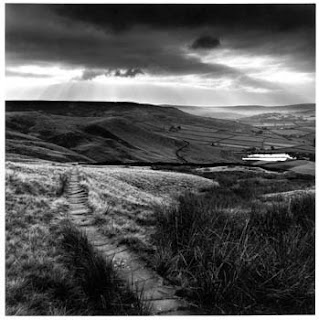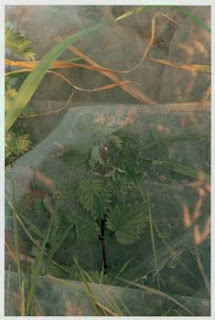For the purposes of this review I have focused on Godwin's landscapes. This is consistent with scope of the Photography 2: Landscape course. As such I have not commented on her early literary portrait and later colour documentary work around West Yorkshire.
To familiarise myself with Godwin's early landscape work, I have reviewed her first guidebook to the Ridgeway. The reproduction of the images in the book is quite poor, but her abilities as a documentary landscape photographer are nevertheless clear. Many of the images might be regarded as workmanlike, but some are atmospheric photographs in the style that became her trademark.
Moonlight Avebury 1974
Her images are known for their clarity, careful composition and control over tonal values. I have witnessed this first hand by visiting two current exhibitions of her work: 'Paul Nash and Fay Godwin' at the Graves Gallery Sheffield and 'Land Revisited' at the National Media Museum.
The former exhibits her work from 'Remains of Elmet' and her photographs are displayed alongside the poems of Ted Hughes. As Ian Jeffrey states in his introduction to this book, Godwin "…registers the long prospects, low curves, abrupt escarpments of the Pennines…". The work also shows how the Industrial Revolution has shaped the landscape of the Calder Valley as in the photograph of Colne, Lancashire 1970.
Colne Lancashire 1970
'Land Revisited' shows many of the original prints from the 'Land' exhibition of 1985. Britain is represented as a place of standing stones, ruined castles and industrial relics - a mysterious place of broad vistas moody skies with desolate and threatening landscapes.
Seeing the original prints was a revelation. The tonal range and detail are just perfect. It is clear that Godwin placed great importance on the printing process. 'Land Revisited' also had some of her contact prints and notebooks giving her directions for printing on display, along with excerpts from the 1986 South Bank Show.
Godwin was tenacious when going after a photograph. The video footage shows her working in the field. From this it is clear that she revisited locations on many occasions to seek out the perfect light and climatic conditions and that once at a location she would spend a great deal of time with a handheld viewfinder searching for just the right composition.
In my view the emotional depth of her black and white landscapes is created by a combination of factors: her photographic skills - use of composition, tone, rhythm and harmony; her tenacity in waiting for just the right time and in particular the right light; and her choice of subject matter - mythic landscapes echoing ancient times.
Path and Resevoir Lumbutts Yorkshire 1977
These elements are illustrated clearly in the photograph Path and Reservoir, Lumbutts, Yorkshire, 1977. The path leads the eye into the picture from the bottom left, a stone wall picks up the path and leads to the reservoir. The reservoir is highlighted, the path and surrounding grass are of medium tone, and the surrounding hills are dark, as is the sky, other than a sunburst on the horizon. This image has a strong composition, makes excellent use of light and depicts a subject showing the influence of man on the landscape and the power and beauty of nature.
Curiously in 'Land' Godwin excluded humans completely from her photographs. However, as one follows the sequence of the book and head south from the remote glens of Scotland to the more populated southern counties of England the intervention of humans on the landscape becomes increasingly apparent. Towards the end of the book Godwin includes images such as one of an abandoned car rising from a lagoon, which might be seen as a warning shot of what was to come in 'Our Forbidden Land'.
The photographs in 'Our Forbidden Land' retain all of the power and technical strength of her earlier work but are also overtly documentary in nature. They tackle a wide range of issues including:
· The adverse effects of overusing pesticides and fertilizers,
· The pollution of waterways, lakes and rivers,
· The restrictions on access to land being imposed by farmers, the Forestry Commission, Water privatization, and MOD acquisition,
· Inadequate transport planning with the consequent overuse of cars,
· Over-marketing of our national heritage, and restricting access to photographers with limited resources to locations such as Stonehenge.
For the first time Godwin was both writer and photographer. Her strong politics and sympathies on the issues are clearly articulated. I was particularly taken by the way she invites the reader to admire and wonder at the British landscape by presenting a photograph of great beauty, and then reveals with another photograph on an nearby page how it is being abused. Here are two such images of the Scottish highlands:
Meall Mor Glencoe 1988
Stob dubh Glen Etive Glencoe 1988
Godwin maintained the momentum of her crusade with a further book, five years later, titled 'On the Edge of the Land', in which she explored the environmental, economic and social issues facing Britain's coastal regions.
During the late 80's Godwin had been able to explore colour photography during her fellowship with the National Museum of Photography in Bradford. She had created a significant body of documentary work at that time. By the 90's she had begun to use colour in some of her landscapes. Her colour work in Bradford seems to have been the genesis of this but also in 1979/80 she had started taking small colour photographs of gardens with a Polaroid sx70 camera. These experiments were to bear full fruit in her later work in 'Glassworks and Secret Lives'.
Untitled from Pioneer Glassworks 1989
The photographs in 'Glassworks and Secret Lives' are intimate landscapes in colour. They are characterized by the use of soft or differential focus with layers of intervening glass, plastic, netting and such like adding to the intrigue and mystery. Untitled, from Pioneer Glassworks, 1989 is an example .
Throughout her photographic career Godwin maintained a sense of humour and was often drawn to images that she called 'Snapshots'. These were amusing images often taken in the landscape.
Simon Roberts, one of Britain's best known photographers today has said of her work: "While I appreciate Godwin’s landscape photographs, the images I’m really drawn to are those which present a dry humour and, much like Tony Ray Jones, a keen eye for the quietly absurd."
Leaping Lurcher, 1972 is one of her best-remembered 'Snapshots'.
Leaping Lurcher 1972







No comments:
Post a Comment